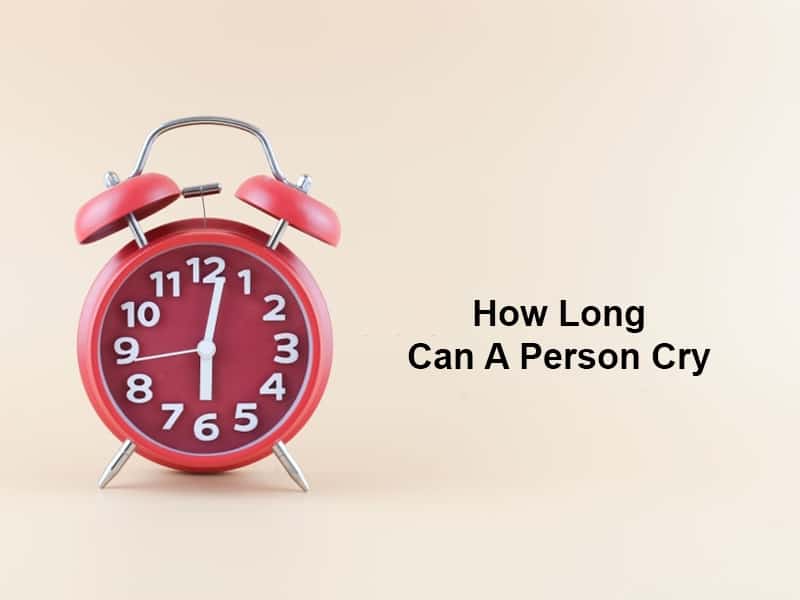Exact Answer: Up to 8 minutes
What exactly is crying? People tend to be confused in similar terms like crying, sobbing, shouting, etc. Crying is an act of shedding tears with voice and sounds followed by small sobs. it is defined as a psychological reaction to intense emotions and physical pain. Crying is a self-soothing act that catalyzes the release of happy hormones like oxytocin and endorphins, which further helps in destressing our mind and body.
Crying, which is an emotional and psychological response of our body, comes with many physical signs like slow but erratic breathing, muscular tremors, etc. Now that we know what is crying, the next question that arises is how long can we cry?

How Long Can We Cry?
| Individuals | Duration of Crying |
| Infants | Up to 60 minutes |
| Children | 15-20 minutes |
| Adults(male) | 2-4 minutes |
| Adults(female) | 6-8 minutes |
There are a lot of factors that determine the duration of how long an individual can cry. When it comes to infants, they may cry up to an hour provided that it is the only verbal form of communication they are aware of. The younger kids may cry due to physical pain for nearly 20 minutes. Moving on to the adult category, we tend to notice a gender-specific bifurcation in crying patterns. Women are believed to possess a higher emotional quotient than men and so is the case with crying duration. In a study, the average duration of crying for adults has been said to be nearly 8 minutes.
Why Do We Cry That Long?
There are several reasons for such particular durations. The mode of communication for infants has always been crying and blabbering. Sometimes, when the parents do not get their child, the crying period increases and the infant keeps on crying.
In the case of kids, it is seen that they cry when they are scolded, when they fell off on the roads hurting themselves or when they are punished in the schools or at home. They feel like if crying is the only way to express their grief and sadness.
With the rise in age, the crying duration gets shorter. We as an individual start living a life where we are busy, we have several tasks in hand and hence a psychological balance is itself maintained. Men are found to be crying for a shorter duration. The reasons for such duration could be the societal norms of “men do not cry” and also the fact that a lot of men are more practical with a lower emotional quotient. Women, at the same instance, cry for 6 to 8 minutes, and after the duration the crying converts into sobs without tears.
The difference in duration also comes with a difference in the frequency of crying of male and female adults. Whereas a man is proven to cry 6 to 17 times a year, a woman may cry any number of times in between 30 to 60.
It may be interesting to note that the longest duration that someone has cried has been recorded in the name of baby Sheila, aged 4 months. The baby cried continuously for a couple of hours, as mentioned in the World’s record book.
Along with a psychological approach, there lies a biological approach too. Shedding few tears a day is considered to be a practice for the healthy eye. But when we start crying immensely due to psychological and emotional triggers, the amount of moisture loss from the eyes increases, leading to roughness and irritation in the eyes and running noses. Therefore, the body goes into an uneasy situation, directing the brain to do something to stop the teary overflow. When emotional fountains flow out of the eyes, it is estimated that we may shed 100 mL of tears in a minute.
Conclusion
It could be seen that crying is an activity that occurs in response to the emotional and physical stimuli of individuals. It could be due to immense happiness and joy, it could be due to anger, sadness, grief, and any other emotion we feel.
While crying is seen to be a stress- reliever, excess crying could also lead to unhealthy patterns. Experts have also witnessed that not all crying is a relieving process. Sometimes, the crying may occur frequently due to underlying mental disorders like severe anxiety and depression. If that is the case, it could lead to a chain of depressive episodes, due to the release of stress hormones like cortisol. In this case, we suggest you reach out for help, as mental health carries an equal weightage as our physical well-being too.





















I find this article very informative! It’s incredible how much crying can tell us about ourselves.
I completely agree. I never knew that crying for men and women was different!
I found the mention of mental health disorders and crying to be particularly poignant.
Yes, it’s important to recognize that crying isn’t always a positive or healthy response.
I’m not sure I agree with the breakdown of crying and gender. Seems like quite a generalization.
I think that’s a valid point. Gender roles shouldn’t dictate how people express their emotions.
Never knew the duration of crying was different based on age and gender. Very interesting.
It’s surprising how little is known about something as fundamental as crying.
I feel that the article makes it clear that crying is a completely natural and healthy response to emotions.
Yes, the article emphasizes the importance of crying for our emotional well-being.
I disagree, I think crying is often seen as a weakness by society for both men and women.
Crying is indeed a fascinating subject! The article did a great job in presenting the numerous facets related to it.
I think the article provided a good introductory understanding of crying, but it doesn’t capture the entire scope of the topic.
I agree, the subject of crying is far more complex than many people realize.
Very interesting. The topic of crying involves such a rich interplay of biological, psychological and social factors.
I completely agree. This article opened my eyes to the complexities involved in crying.
I feel like this article really highlights the importance of understanding the complexities of crying.
Absolutely, crying is never as simple as it seems.
I think the article was guilty of oversimplifying the biological and emotional aspects of crying.
Crying for women is very different from crying for men, interesting.
I think it’s interesting how this information is grounded in biological differences!
Interesting to learn about the negative effects that excessive crying can have on our health.
I think the negative effects of crying were really overstated in this article, though.
Absolutely, crying doesn’t always relieve stress as commonly thought.